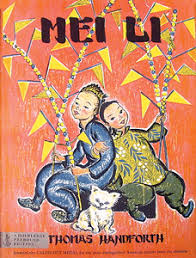“Mei Li,” the Second Caldecott
Listen to the Recess! Clip
| Author | Rita Smith |
| Air Date | 7/12/2005 |

“Mei Li,” the Second Caldecott Transcript
A book entitled Mei Li [May Lee] written and illustrated by Thomas Handforth, was the winner of the Caldecott Award in 1939, the second year the Award for the most distinguished American picture book was presented. The story is about a little Chinese country girl who goes to the nearby city with her brother to attend the New Year’s Fair, returning to their farm in time to welcome the arrival of the Kitchen God at midnight. The book offers children a visually fascinating introduction to the landscape and people of China along with a satisfying universal story of a child who ventures forth, has exciting adventures and returns safely home.
The black and white lithographs spread across the pages are bold and vital. The sturdy buildings of the cityscape create a dignified setting as counterpoint to the exuberance of the foregrounded figures: acrobats, fortune tellers, bareback horse riders, tightrope walkers, performing bears and Mei Li herself. An early art teacher of Handforth’s suggested that he draw the space around the figure rather than the figure itself and in Mei Li it is the white space that first captures the readers’ attention, draws the eye across the page and defines the pictures.
Mei Li, like every book, has its creation story. In 1934, Handforth was living in Peking, China, in a large old house, spending a good part of every day sketching the life that teemed around him. He invited sword dancers, contortionists, jugglers, puppeteers, minstrels and acrobats into his studio to pose for him, plying them with cups of tea and keeping them entertained with imitations of Charlie Chaplin’s walk. They posed for him over and over and he got to know them well.
He wanted to bring all these friends of his together in a picture book for children, but could not decide who should play the leading role. Then he met Mei Li, a little girl who had been abandoned at an early age and left on the doorstep of a missionary’s home. She was adopted by and lived with an American lady in Peking and when the woman was called back to the United States for a year, Mei Li was left in the care of the wife of a poor gardener. Handforth discovered her as he walked past a neighboring compound and saw her peering at him from behind her gate. He struck up a friendship with the family and discovered that Mei Li was a determined, energetic child who managed everything and everyone around her. She needed no urging to pose for him and before long she was running the whole show, even dragging her friends in to be drawn by the artist. She took over the studio and made herself the star, totally charming Handforth, who soon realized that in Mei Li he had discovered the central character for his children’s book.
Sources:
Handforth, Thomas, Mei Li, Garden City, New York: Doubleday & Company, Inc. 1938.
Handforth, Thomas. “The Story of ‘Mei Li’” in The Hornbook Magazine, vol. xv, no. 4, July/August, 1939, pp.237-240.
SHARE
Share this content on these platforms.